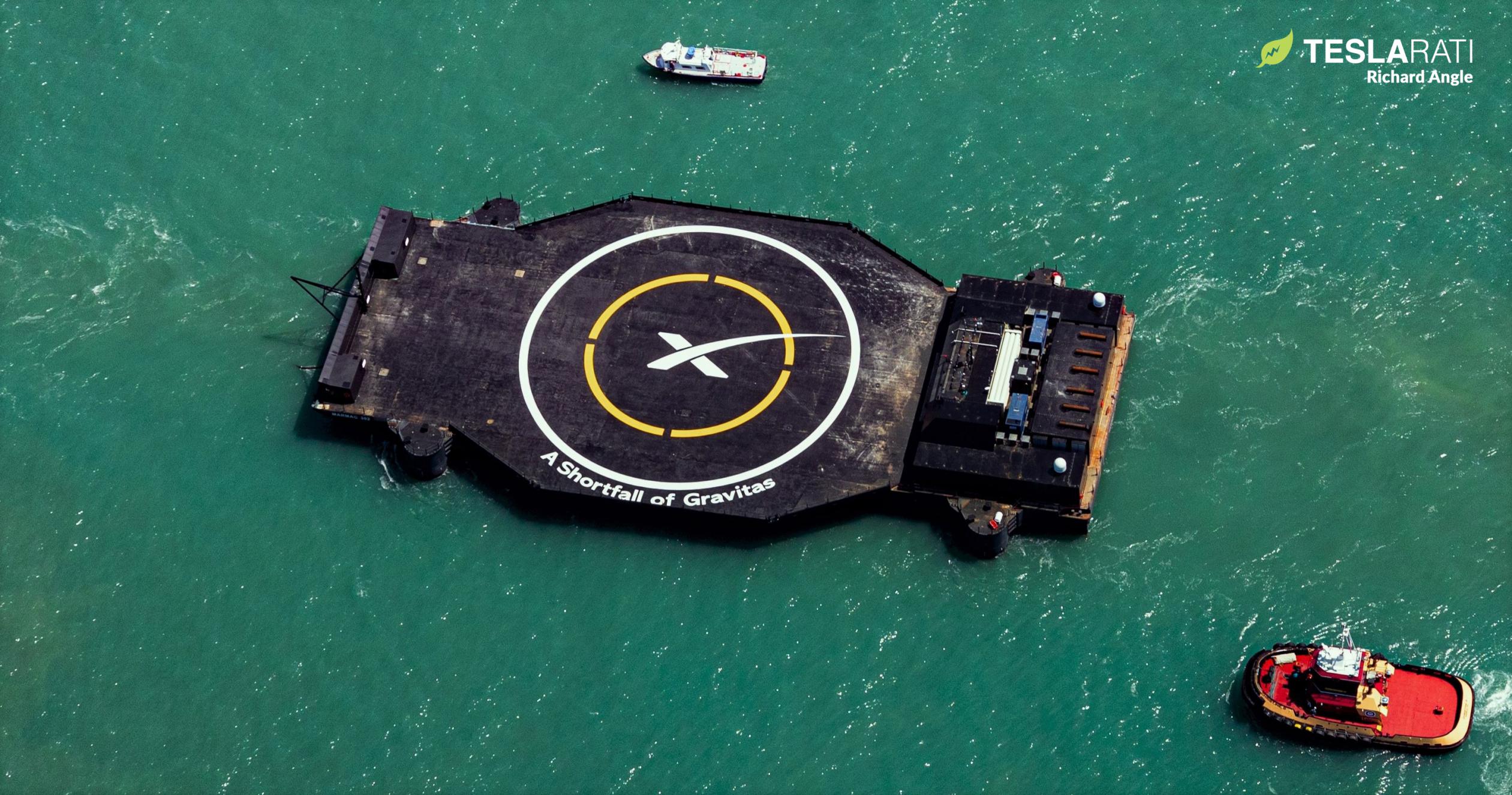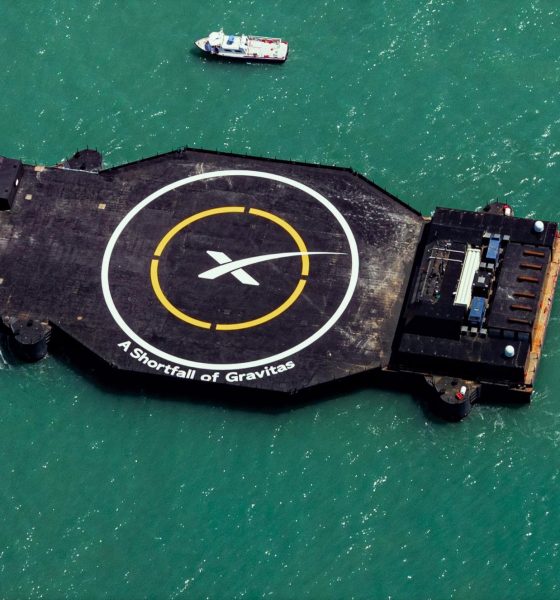SpaceX’s newest drone ship is on its way out into the Atlantic Ocean for a Starlink mission that will break the company’s record for annual launch cadence.
Somewhat confusing known as Starlink Shell 4 Launch 3 or Starlink 4-3, the batch of 53 laser-linked V1.5 satellites is scheduled to fly before Starlink 4-2 for unknown reasons and at the same time as Starlink 2-3 is scheduled to fly before Starlink 2-2 on the West Coast. Regardless of the seemingly unstable launch order, perhaps related to the recent introduction of Starlink’s new V1.5 satellite design, drone ship A Shortfall of Gravitas’ (ASOG) November 27th Port Canaveral confirms that SpaceX is more or less on track to launch Starlink 4-3 no earlier than (NET) 6:20 pm EST (23:20 UTC) on Wednesday, December 1st.
In a bit of a return to stride after launching 20 times in the first six months but only three times in the entire third quarter of 2021, Starlink 4-3 is currently the first of four or even five SpaceX launches scheduled in the last month of the year. Nevertheless, if Starlink 4-3 is successful, it will also set SpaceX up to cross a milestone unprecedented in the history of satellite launches.
Specifically, Starlink 4-3 is SpaceX’s 16th dedicated Starlink launch of 2021 and will mark 951 Starlink satellites safely delivered to orbit since January 20th. If, as CEO Elon Musk has telegraphed is the plan, SpaceX intends to complete one more dedicated Starlink launch in December (either Starlink 2-2 or 2-3), the company could round out 2021 having launched more than a thousand satellites in a single year.
Thanks to Starlink, 2020 was the first year in history in which more than a thousand satellites (technically 1283) were launched into orbit. Now, in 2021, there’s a good chance that SpaceX Starlink launches alone will account for more than a thousand satellites launched in one year. Altogether, SpaceX will likely end the year having singlehandedly launched a total of more than 1240 satellites in 2021 – and despite only completing 3-4 Starlink launches in the last seven months of the year compared to 13 in the first five months.
For SpaceX and Starlink, that’s great news. In March and November 2018, the FCC approved two SpaceX applications to launch and operate constellations of ~4400 and ~7500 Starlink satellites – a total of around 11,900 satellites. To avoid having its licenses revoked, SpaceX – like all other FCC constellation applicants – is required to launch half of its licensed constellation within six years of its license receipts and full constellation within nine years. For SpaceX, that means it has to launch at least ~2200 satellites operating around 550 km (340 mi) and ~3750 satellites operating around 350 km (~220 mi) by March and November 2024, respectively.
With a bit less than 1700 Starlink satellites currently functioning in orbit, even if SpaceX merely repeats its 2021 cadence, it will be on track to outright finish Starlink’s first 4400-satellite phase by mid-2024 and should easily cross the halfway mark by mid-2022 – years ahead of schedule for both. However, simultaneously hitting Starlink’s very low Earth orbit (VLEO) deployment milestones will still be a massive challenge. Given that SpaceX has yet to launch a single VLEO Starlink spacecraft three years after license approval, it now has less than three years to launch ~3750 VLEO satellites on top of at least 500 more LEO satellites.
If SpaceX can replicate its H1 2021 Starlink launch cadence throughout 2022, completing at least 26 launches in 52 weeks, it may actually have a shot at pulling off a cadence close to what is needed to meet its FCC deployment requirements (an average of 1400 satellites per year for the next three years). If SpaceX simply aims for the average annual numbers needed to complete the full ~11,900-satellite Starlink constellation by November 2027, it will need to launch around 1800-2000 satellites per year – equivalent to 35-40 Falcon 9 rockets.

News
Elon Musk’s Grokipedia surges to 5.6M articles, almost 79% of English Wikipedia
The explosive growth marks a major milestone for the AI-powered online encyclopedia, which was launched by Elon Musk’s xAI just months ago.

Elon Musk’s Grokipedia has grown to an impressive 5,615,201 articles as of today, closing in on 79% of the English Wikipedia’s current total of 7,119,376 articles.
The explosive growth marks a major milestone for the AI-powered online encyclopedia, which was launched by Elon Musk’s xAI just months ago. Needless to say, it would only be a matter of time before Grokipedia exceeds English Wikipedia in sheer volume.
Grokipedia’s rapid growth
xAI’s vision for Grokipedia emphasizes neutrality, while Grok’s reasoning capabilities allow for fast drafting and fact-checking. When Elon Musk announced the initiative in late September 2025, he noted that Grokipedia would be an improvement to Wikipedia because it would be designed to avoid bias.
At the time, Musk noted that Grokipedia “is a necessary step towards the xAI goal of understanding the Universe.”
Grokipedia was launched in late October, and while xAI was careful to list it only as Version 0.1 at the time, the online encyclopedia immediately earned praise. Wikipedia co-founder Larry Sanger highlighted the project’s innovative approach, noting how it leverages AI to fill knowledge gaps and enable rapid updates. Netizens also observed how Grokipedia tends to present articles in a more objective manner compared to Wikipedia, which is edited by humans.
Elon Musk’s ambitious plans
With 5,615,201 total articles, Grokipedia has now grown to almost 79% of English Wikipedia’s article base. This is incredibly quick, though Grokipedia remains text-only for now. xAI, for its part, has now updated the online encyclopedia’s iteration to v0.2.
Elon Musk has shared bold ideas for Grokipedia, including sending a record of the entire knowledge base to space as part of xAI’s mission to preserve and expand human understanding. At some point, Musk stated that Grokipedia will be renamed to Encyclopedia Galactica, and it will be sent to the cosmos.
“When Grokipedia is good enough (long way to go), we will change the name to Encyclopedia Galactica. It will be an open source distillation of all knowledge, including audio, images and video. Join xAI to help build the sci-fi version of the Library of Alexandria!” Musk wrote, adding in a later post that “Copies will be etched in stone and sent to the Moon, Mars and beyond. This time, it will not be lost.”
News
Tesla Model 3 becomes Netherlands’ best-selling used EV in 2025
More than one in ten second-hand electric cars sold in the country last year was a Tesla Model 3.

The Tesla Model 3 became the most popular used electric car in the Netherlands in 2025, cementing its dominance well beyond the country’s new-car market.
After years at the top of Dutch EV sales charts, the Model 3 now leads the country’s second-hand EV market by a wide margin, as record used-car purchases pushed electric vehicles further into the mainstream.
Model 3 takes a commanding lead
The Netherlands recorded more than 2.1 million used car sales last year, the highest level on record. Of those, roughly 4.8%, or about 102,000 vehicles, were electric. Within that growing segment, the Tesla Model 3 stood far ahead of its competitors.
In 2025 alone, 11,338 used Model 3s changed hands, giving the car an 11.1% share of the country’s entire used EV market. That means more than one in ten second-hand electric cars sold in the country last year was a Tesla Model 3, Auto Week Netherlands reported. The scale of its lead is striking: the gap between the Model 3 and the second-place finisher, the Volkswagen ID3, is more than 6,700 vehicles.
Rivals trail as residual values shape rankings
The Volkswagen ID.3 ranked a distant second, with 4,595 used units sold and a 4.5% market share. Close behind was the Audi e-tron, which placed third with 4,236 registrations. As noted by Auto Week Netherlands, relatively low residual values likely boosted the e-tron’s appeal in the used market, despite its higher original price.
Other strong performers included the Kia Niro, the Tesla Model Y, and the Hyundai Kona, highlighting continued demand for compact and midsize electric vehicles with proven range and reliability. No other model, however, came close to matching the Model 3’s scale or market presence.
News
Tesla Model Y Standard Long Range RWD launches in Europe
The update was announced by Tesla Europe & Middle East in a post on its official social media account on X.

Tesla has expanded the Model Y lineup in Europe with the introduction of the Standard Long Range RWD variant, which offers an impressive 657 km of WLTP range.
The update was announced by Tesla Europe & Middle East in a post on its official social media account on X.
Model Y Standard Long Range RWD Details
Tesla Europe & Middle East highlighted some of the Model Y Standard Long Range RWD’s most notable specs, from its 657 km of WLTP range to its 2,118 liters of cargo volume. More importantly, Tesla also noted that the newly released variant only consumes 12.7 kWh per 100 km, making it the most efficient Model Y to date.
The Model Y Standard provides a lower entry point for consumers who wish to enter the Tesla ecosystem at the lowest possible price. While the Model 3 Standard is still more affordable, some consumers might prefer the Model Y Standard due to its larger size and crossover form factor. The fact that the Model Y Standard is equipped with Tesla’s AI4 computer also makes it ready for FSD’s eventual rollout to the region.
Top Gear’s Model Y Standard review
Top Gear‘s recent review of the Tesla Model Y Standard highlighted some of the vehicle’s most notable features, such as its impressive real-world range, stellar infotainment system, and spacious interior. As per the publication, the Model Y Standard still retains a lot of what makes Tesla’s vehicles well-rounded, even if it’s been equipped with a simplified interior.
Top Gear compared the Model Y Standard to its rivals in the same segment. “The introduction of the Standard trim brings the Model Y in line with the entry price of most of its closest competition. In fact, it’s actually cheaper than a Peugeot e-3008 and costs £5k less than an entry-level Audi Q4 e-tron. It also makes the Ford Mustang Mach-E look a little short with its higher entry price and worse range,” the publication wrote.










